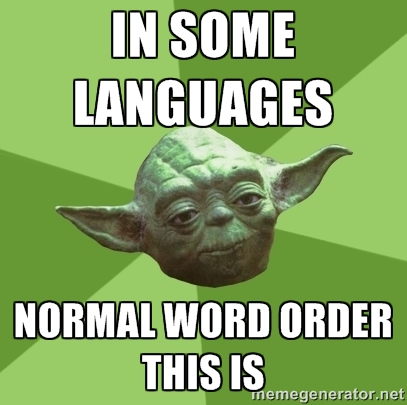Have you ever had difficulties with combining Russian words? We’re sure you know what we’re talking about. Russian word order is important because it makes sentences make sense. Without understanding the main principles of combining words, you won’t be able to communicate with native speakers while, let’s say, vacationing in Russia over the holidays or chatting on social media.Russian sentence structure is one of the most significant parts of learning the grammar rules of this language. If you learn how to make sentences word by word now, you probably won’t have problems with more difficult themes in the future. So let’s start studying!
Table of Contents
- Overview of Word Order in Russian
- Basic Word Order with Subject, Verb, and Object
- Word Order with Prepositional Phrases
- Word Order with Modifiers
- How to Change Your Sentence into a Yes-or-No Question
- Translation Exercises
- Conclusion
1. Overview of Word Order in Russian
The Russian language word order is SVO, but the existing grammar rules allow us to change it. So, sometimes, the typical SVO Russian word order can become VSO. That’s why we can say that word order in Russian sentences is quite flexible.
So, does word order matter in Russian? When comparing word order in English and Russian, we can notice one big difference. Russian word order doesn’t matter grammatically as much as English word order does.
Before having Russian sentence structure practice, you should definitely learn the most popular Russian phrases and words. It’s impossible to make sentences without knowing them by heart.
If you’re an advanced speaker, you may read Russian books and learn new words from them.
2. Basic Word Order with Subject, Verb, and Object
According to the basic Russian word order, you must start your sentence with the subject. Then comes the verb, followed by the object. If you use this word order in Russian sentences, you’ll never make a mistake. For example:
- Я читаю книгу. (Ya chitayu knigu.) — “I read a book.”
There are also some cases when you can use VSO instead of SVO. It’s appropriate if the sentence contains two verbs, and you want to emphasize the first one. It sounds good if you’re telling a story. For example:
- Читаю я книгу и вдруг… (Chitayu ya knigu i vdrug…) — “I’m reading a book, and suddenly…”
Be careful with VSO in Russian, though. It may sound really weird if you use it while making an order in a restaurant, talking to a stewardess during your flight to Russia, in an emergency, or in other formal situations.
3. Word Order with Prepositional Phrases
Prepositional phrases answer the following questions:
- Where?
- When?
- In what way?
Prepositional phrases that answer the question “Where?” are typically used at the end of the sentence, after the object:
- Я читаю книгу дома. (Ya chitayu knigu doma.) — “I read a book at home.”
In Russian sentence structure, prepositional phrases that answer the question “When?” are put either at the very beginning or at the end of a sentence. The meaning of the phrase will change a bit, though. For example:
- Сегодня я читаю книгу. (Segodnya ya chitayu knigu.) — “Today, I read a book.”
- In this case, this sentence answers the question “What did I do today?”
- Я читаю книгу сегодня. (Ya chitayu knigu segodnya.) — “I read a book today.”
- This one answers the question “When did I read a book?”
Prepositional phrases that answer the question “In what way?” can be used right after the noun or at the end, after the verb. Both variants are grammatically correct, but the first one sounds more natural:
- Я увлеченно читаю книгу. (Ya uvlechyonno chitayu knigu.) — “I enthusiastically read a book.”
- Я читаю книгу увлеченно. (Ya chitayu knigu uvlechyonno.) — “I read a book enthusiastically.”
When there are two (or even more) prepositional phrases, you should use them in the following order:
- Put the prepositional phrase of time in the first place, before the noun.
- Add the prepositional phrase that answers the question “In what way?“ after the noun.
- Use the prepositional phrase of place after the object, at the end.
Here’s an example:
- Сегодня я увлеченно читаю книгу дома. (Segodnya ya uvlechyonno chitayu knigu doma.) — “Today, I enthusiastically read a book at home.”
If you don’t want to learn all these rules about building sentences in Russian, you may always put the prepositional phrase at the end of the sentence. Of course, doing so is appropriate only for beginners. Advanced students must know and use more complex rules regarding sentence structure in Russian.
4. Word Order with Modifiers
In most cases, the modifier is an adjective which describes something. In Russian word order, adjectives are always used before nouns:
- Я читаю интересную книгу. (Ya chitayu interesnuyu knigu.) — “I read an interesting book.”
If there are two or more adjectives in the sentence, you should:
- Firstly, use the one which expresses your own opinion about the subject or marks something about the subject that’s not very stable.
- Use the adjective which denotes a very stable aspect as close to the noun as possible.
For example:
- Я читаю интересную научную книгу. (Ya chitayu interesnuyu nauchnuyu knigu.) — “I read an interesting scientific book.”
Note that Russian sentence structure with adjectives is more or less flexible. There are no actual Russian word order rules that say you must use one type of adjective before another (e.g. shape before color). Try not to think too hard about how to order words in Russian when it comes to adjectives.
Other modifiers include the determiner, the numeral, and the possessive. According to the most typical word order in Russian, all modifiers like these come before the noun:
- Я читаю эту книгу. (Ya chitayu etu knigu.) — “I read this book.”
- Я читаю одну книгу. (Ya chitayu odnu knigu.) — “I read one book.”
- Я читаю его книгу. (Ya chitayu yego knigu.) — “I read his book.”
5. How to Change Your Sentence into a Yes-or-No Question
Typical Russian sentence structure makes it really easy to change affirmative constructions into yes-or-no-questions. If you want your Russian question word order to be correct, follow our instructions:
- Put the verb at the beginning.
- Add the conjunction ли (li) after the verb.
- Then use the noun and the object.
Here’s an example:
- Читаю ли я книгу? (Chitayu li ya knigu?) — “Do I read a book?”
6. Translation Exercises
We hope that you’ve read the information above thoroughly and understand the basic Russian sentence structures. Now we need to practice a bit with new sentences. We’ll use the most common Russian word order: SVO.
Please, stop comparing Russian sentence structure to that of English. They are both easy and comprehendible, believe us.
First of all, try to translate this phrase using your knowledge about how Russian sentences are structured:
- “I watched a movie.”
You may use the Russian dictionary if you don’t know the translations of some words.
If it’s difficult for you, think about Russian sentence structure compared to that in English. What do you know about them? They’re both SVOs! That’s why you can translate the simplest sentence word by word without the fear of making mistakes.
The correct Russian translation of the sentence above is:
- Я посмотрел фильм. (Ya posmotrel fil’m.)
Now let’s translate a slightly more difficult variant of this sentence:
- “I watched a good movie.”
If you’re struggling, look at our Russian sentence structure examples. There you’ll see that the adjective always comes before the noun:
- Я посмотрел хороший фильм. (Ya posmotrel khoroshiy fil’m.)
Now it’s time to make our English sentence more difficult. Translate this one:
- “I watched a good movie yesterday.”
Don’t panic! There are two ways to make this sentence:
- Вчера я посмотрел хороший фильм. (Vchera ya posmotrel khoroshiy fil’m.)
- Я посмотрел хороший фильм вчера. (Ya posmotrel khoroshiy fil’m vchera.)
Now try to translate the question:
- Did I watch a good movie yesterday?
There are two correct ways to translate it:
- Посмотрел ли я вчера хороший фильм? (Posmotrel li ya vchera khoroshiy fil’m?)
- Посмотрел ли я хороший фильм вчера? (Posmotrel li ya khoroshiy fil’m vchera?)
Sometimes there’s more than one appropriate way to express your thoughts in Russian.
7. Conclusion
You’ve learned a lot about Russian sentence structure and word order. We gave you not only the basic rules, but also some advanced techniques to build complex Russian sentences. Of course, it may seem too difficult right now. But don’t forget that Russian people don’t even think about how to combine words while speaking or writing. You only need some practice to do the same.
No one can fully cover the theme of sentence structure in Russian in one article, because this language is too rich. We’re sure you still have some questions: how to structure a sentence in Russian if there are two subjects and two verbs, how to form complex questions, how Russian sentence structure works in sentences with relative clauses, etc.
If you want to know more about this theme and find the answers to the above-mentioned questions, explore RussianPod101.com. Here you’ll find lots of free materials regarding vocabulary, grammar, and spelling. You’ll be able to download some useful information about Russian sentence structure.Do you want to try personal coaching? You can check our Premium PLUS service MyTeacher and take the assessment test to get started.

Adding Parts Together
Russian words are structured similar to English with a root meaning and prefixes or suffixes that modify the meaning.
For example, “capital-ism” has the same structure in English and Russian!
root+suffix капитал-изм capital-ism (capital=wealth, -ism=principle) [1]
Prefixes can be combined within one word to incrementally modify the meaning of the verb further.
Such as the Russian “joke” verb:
недоперепить- To drink more than is possible, but less than you want.
пить – to drink (means to drink alcohol when the drink is not specified)
перепить – to drink too much
доперепить – to successfully complete the act of drinking too much, to drink enough to have drunk too much
недоперепить – To fail to complete the act of drinking too much. To fall short of the original goal of drinking too much. [2]
More Examples
сотрудник coworker
со+труд+ник co+work+er [3]
безопасность safety
без+опасность safety (without+danger)
опас+ность danger (fear-carry)
“I would comment about “ходить” (to walk) and “находить” (to find). […] they share the same root for a reason, so instead of blindly saying they are totally different you actually need to develop some understanding – “ходить” is to walk, “на” is on/onto – how do you find things? You walk and step/bump onto (into them); the relation must be as clear as day!
Of course the meaning seems distant, but use your imagination and manage to see the connection – that’s your key to feeling the language.
Another example: The word “необходимый” – if you check its meaning in the dictionary you find “necessary” (quite far from “ход” – walking, isn’t it?). But look deeper: “обходить” means “to go around”, which can also be “avoid”. “Не” – is negation – so anything which you can’t go/avoid without is necessary”. [4]
Learning Technique
When you begin learning vocabulary, it’s really helpful to recognise that parts of the word from the start. You can use roots to associate related words and remember them. It also stops confusing a lot of unrelated words with the same prefix because you can’t tell them apart. To some extent they can be used for guessing unfamiliar words, but be wary there are look-alikes.
English has also borrowed a substantial number of words from Latin and French, whose roots sometimes look more like Russian roots than the native English roots do. For example, the English root SET corresponds to Latin SED (as in sedentary, session, preside, president), which is more like the Russian root СЕД.
It will be helpful for you to draw upon this knowledge you have of Latin roots in your English vocabulary when you learn Russian words; for example the relationship of the Russian word председатель ‘chairman, president’ with English sit may not be immediately obvious, but its root -сед- is clearly related in form and meaning to the latinate English word president. [5]
Modified Roots
In English, the root can change slightly, for example “sit” and “sat”. In Russian constonants can change between their voiced and voiceless pairs or words get shortened to make them easier to say.
For example, ходить to walk -> хожу I walk. The root ход changed to хож. [6]
Common Prefixes and Suffixes
Like English, there are too many prefixes and suffixes to list. But there are more useful and less useful ones.
Motion: Yearlyglot: Finally understand those Russian prefixes
Names: Master Russian: Suffixes of Russian Nouns
And Finally…
Before you visit another sale, remember that in Russian the words “scam” and “discount” are single-root.
Прежде чем посетить очередную распродажу, вспомните, что в русском языке слова “кидалово” и “скидка” – однокоренные.
Russian sentence structure and word order are flexible. It means that you can put words in different places in the sentence and the meaning will stay pretty much the same.
For example, in English, we say: SHE IS A TEACHER. If we try IS TEACHER A SHE or anything else, the meaning will change.
In Russian, we can do this, but… it’s not random! It depends on the context and emotions of the speaker.
For example,
Я БЫЛА НА РАБОТЕ – I was at work (normal sentence)
НА РАБОТЕ Я БЫЛА!!! – I was at work (but when somebody asked you 100 times already :D)
БЫЛА Я КАК-ТО НА РАБОТЕ… – I was at work once… (and then follows some story)
You see? It’s not that random at all!
So please just stay with the basic word order: Subject + Verb + Object
Examples (don’t worry about the endings, we’ll learn them later, now only the word order is important):
Он работает сегодня – He is working today;
Мама читает газету – Mom is reading a newspaper;
Дарья гуляет в парке – Daria is walking in the park.
QUESTIONS IN RUSSIAN
So-called YES/NO questions are formed just with intonation (watch the video – 15:30). You don’t have to change the word order to make a question.
In English: She is a teacher. – Is she a teacher?
In Russian: Она учитель. – Она учитель?
In English: This is a girl. – Is this a girl?
In Russian: Это девушка. – Это девушка?
In English: He is sick. – Is he sick?
In Russian: Он болеет. – Он болеет?
Also, you can use the question words to make questions. Here are some of them:
Кто? – Who?
Что? – What?
Где? – Where?
Когда? – When?
Почему? Зачем? – Why?
Read the examples below.
Because you know I had to include Yoda
One of the first things a learner of Russian hears about the Russian sentence structure is that, unlike in English, the word order (порядок слов) is relatively free. While understandably daunting for the beginner, this order not only allows for greater flexibility, but also helps with the logical emphasis in the sentence. What does that mean for the English-speaking learner?
First of all, an awareness of the Russian word order may answer some of the questions you may have about the lack of articles in Russian. If Russian has no articles, how do people know if the thing being talked about is new or known? Well, the word order in Russian places the known pieces of information – what is called the theme (тема) – at the beginning of a sentence, and the new pieces – what’s called the rheme (рема), at the end. For example,
В комнату вошёл человек
means “A person entered the room,” and
Человек вошёл в комнату
means “The person entered the room.” In other words, the listened can infer whether the thing is known or unknown without any articles thanks to its placement in the sentence.
We can see this tendency in newspaper headings. For example, an article in Газета is titled “В Колорадо разбился двухмоторный самолёт” (A twin-engine plane crashed in Colorado). The emphasis is placed on the plane or, perhaps, the type of plane, that crashed, and Colorado is given as background information.
Likewise, an article in the Известия (News) newspaper is called “На Mail.ru появится платный контент” (“Paid content to be hosted on mail.ru,” a popular email service in Russia). The author put the new information about the paid content last. Word order is a powerful tool for conveying emphasis. For example, the tagline of the most popular Russian search engine Яндекс (Yandex.ru) is “Найдётся всё” (Everything will be found), which makes it read like “Whatever it is you’re looking for, we’ll find it.”
Next time you listen to a song in Russian, pay attention to what words are placed at the end of each sentence. For example, the famous song “Я спросил у ясеня” (“I asked the ash tree”) tells about a man who is looking for his beloved (любимая). He ends up asking his friend where his beloved is, to hear, “была тебе любимая, а стала мне жена” (she was a beloved to you, and now she’s a wife to me). Note how the words “любимая” and “жена” are placed towards the end to show that this change of relationship status is the point of the sentence.
So if you ever need some guidance when putting words together into sentences in Russian, try asking yourself what the point of your sentence is. Once you’ve identified this new and important information, feel free to place it last for emphasis!
Russian grammar —> Word order in Russian
In English, the word order plays an important role because it shows the relationships between parts in the sentence (subject, object, etc.). For example, if we say «Cats eat mice», we clearly understand that «cats» is here the subject of the action «eat» and the object of this action is «mice». If we switch the position of nouns «cats» and «mice», we get «Mice eat cats», a sentence with a different meaning. So, in English sentence the grammatical sense depends on word order.
However, Russian word order is very flexible. The relationships between parts of the Russian sentence are shown by the endings of words. Depending on the grammatical sense and role in the sentence, Russian words have different endings.
Look at the following example:
Кошки едят мышей. — Cats eat mice.
In the Russian sentence, the object of the action is shown by the ending -ей of the word мышей. That is why, if you change the position of the Russian words, the overall meaning of the sentence will not change. You can say:
Кошки едят мышей.
Мышей едят кошки.
Едят кошки мышей.
Едят мышей кошки.
In these sentences, the subject and the object of the action «eat» remain the same.
So, because of words endings, the parts of the Russian sentence can go in almost any order without causing any misunderstanding on the part of the listener.
If you want to know more about word endings and their grammatical role in Russian, we recommend you to see the page Cases in Russian on our website.
For the beginner in Russian there is nothing very important to remember about word order – other than the fact that it is very flexible. For example, while translating a Russian sentence, you can use the word order of the English sentence and native speakers will always understand you.
At the same time, Russian word order has its own peculiarities. One of these peculiarities is that in written Russian new information (or emphasized information) comes at the end of the sentence. For example, look at the sentence:
Мария едет в Москву. — Maria goes to Moscow.
The emphasis is on the word Москва (Moscow), it is a new information because this sentence tells where Maria goes. If another word order is used:
В Москву едет Мария. – It is Maria who goes to Moscow.
The emphasis is on the word Мария (Maria), and, in this case, the sentence tells who goes to Moscow.
In a conversation, the word order is more flexible since intonation and stress may be used to show the emphasized information in a sentence.







